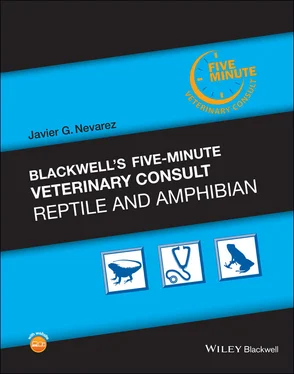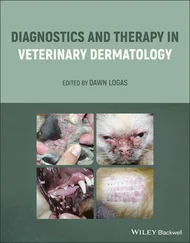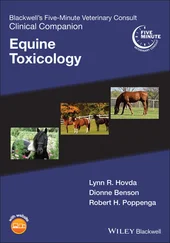1 Gandar F, Wilkie GS, Gatherer D, et al. The genome of a tortoise herpesvirus (testudinid herpesvirus 3) has a novel structure and contains a large region that is not required for replication in vitro or virulence in vivo. J Virol 2015;89(22):11438–11456.
2 Marschang RE. Virology. In: Divers SJ, Stahl SJ, eds. Mader’s Reptile and Amphibian Medicine and Surgery. St. Louis, MO: Elsevier; 2019:247–269.
3 Marschang RE. Viruses infecting reptiles. Viruses 2011;3:2087–2126.
AuthorRachel E. Marschang, PD, Dr. med. vet., DECZM (Herpetology), FTÄ Mikrobiologie
Hexamita
 BASICS
BASICS
DEFINITION/OVERVIEW
Hexamita is a small flagellate parasite which can be found in the intestinal tract of chelonians and snakes. Hexamita parva is the usual cause of disease in chelonians. Disease has not been reported in other reptiles.
Infection is thought to occur by ingestion of an infective cyst, which passes into the gastrointestinal tract.
Reproduction is by simple binary fission. Subsequently, the parasite may ascend via the bile ducts to the gall bladder or via the ureters to the kidneys, where it encysts, resulting in inflammation.
Alternatively, Hexamita may pass through the gastrointestinal tract without resulting in disease.
Transmission can occur via urine or feces.
Disease has been described in a wide variety of chelonian species with no “typical” signalment.
Animals with Hexamita infection may be asymptomatic or have non‐specific signs such as lethargy and reduced appetite.
If significant renal pathology is present, weight loss and polydipsia may be seen.
Poor hygiene will increase the risk of disease transmission.
Pre‐existing renal or biliary disease or concurrent parasite infection have been suggested to be potential risk factors.
 DIAGNOSIS
DIAGNOSIS
Identification of the parasite in a sample of urine ± feces may lead to suspicion of disease, but flagellates are not always associated with pathology.
Definitive diagnosis requires detection of the parasite on renal biopsy in a live animal.
Parasites should be distinguished from commensal intestinal flagellates, especially trichomonads, which may commonly be seen in fecal samples or urine samples contaminated with feces.
Analysis of a fresh urine sample may reveal small fast‐moving flagellates (< 8 microns) characterized by six anterior flagella.
In small samples the parasite will rapidly desiccate and die.
Renal biopsies should be submitted for histopathology.
Biochemistry may be helpful to indicate degree of renal damage.
Characteristic postmortem findings include pale enlarged kidneys with dilated collecting tubules. Bile ducts appear thickened with a dilated lumen.
On histopathological examination, flagellates may be visualized within the renal tubules and bile ducts with associated inflammatory changes.
 TREATMENT
TREATMENT
APPROPRIATE HEALTH CARE
Treatment involves both eliminating the parasite and supportive care of the renal disease.
Euthanasia may be considered in severe cases of renal failure.
Some patients may be anorexic and severely dehydrated on presentation.
Fluid deficits should always be corrected and nutritional support provided as needed.
CLIENT EDUCATION/HUSBANDRY RECOMMENDATIONS
Hygiene measures should be reviewed to minimize the risk of disease transmission.
 MEDICATIONS
MEDICATIONS
DRUG(S) OF CHOICE
Metronidazole is the most common choice for treating Hexamita.
Various treatment regimens have been recommended ranging from 100–125 mg/kg PO once, then repeated after 14 days to 50 mg/kg PO q24h for 3–5 days for severe infections.
Hepatotoxicity and CNS toxicity have occasionally been reported in other species following metronidazole use, so care should be taken if pre‐existing hepatic dysfunction is suspected.
 FOLLOW‐UP
FOLLOW‐UP
PATIENT MONITORING
Response to therapy is usually monitored by a reduction in clinical signs (e.g., improved appetite).
Repeat blood samples can also be taken to recheck renal parameters.
EXPECTED COURSE AND PROGNOSIS
The prognosis for patients with extensive biliary or renal damage is poor, but if diagnosed early the condition can be managed successfully.
If left untreated, the disease will slowly progress to renal failure and death.
 MISCELLANEOUS
MISCELLANEOUS
COMMENTS
N/A
N/A
N/A
CNS = central nervous system
PO = per oram
Veterinary Information Network: www.vin.com
1 Johns JD. Urogenital system. In: Girling SJ, Raiti P, eds. BSAVA Manual of Reptiles, 2nd ed. Quedgeley, UK: BSAVA; 2004:261–272.
2 Zwart P, Truyens EHA. Hexamitiasis in tortoises. Vet Parasitol 1975;1(2):175–183.
AuthorJoanna Hedley, BVM&S, DZooMed (Reptilian), DECZM (Herpetology), MRCVS
Hyperglycemia
 BASICS
BASICS
DEFINITION/OVERVIEW
Hyperglycemia is abnormally high blood glucose concentration. In most species, glucose concentrations fluctuate. Normal glucose concentration ranges from 60 mg/dl to 200 mg/dl (3.3–11 mmol/l).
The etiology is largely unknown
Transient hyperglycemia may be postprandial or stress induced.
Elevated glucose may be seen during ovulation, and in certain neoplastic conditions.
Iatrogenic from prior glucose or glucocorticosteroid administration.
Читать дальше

 BASICS
BASICS DIAGNOSIS
DIAGNOSIS TREATMENT
TREATMENT MEDICATIONS
MEDICATIONS FOLLOW‐UP
FOLLOW‐UP MISCELLANEOUS
MISCELLANEOUS










